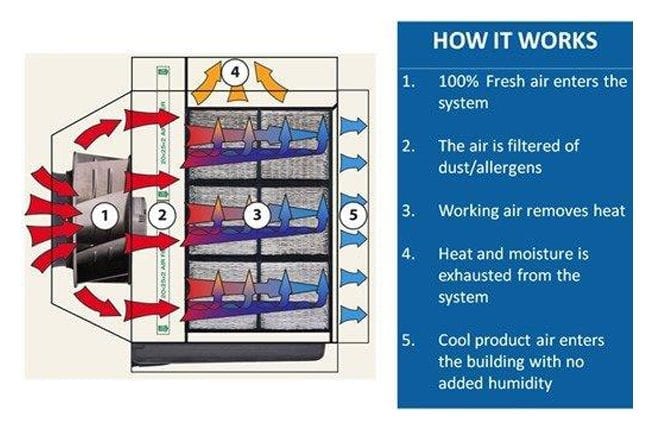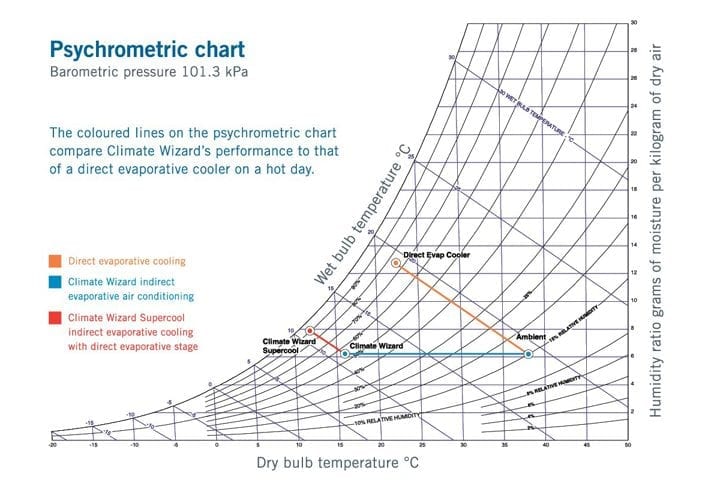Indirect evaporative coolers feature a hyper efficient air to air heat exchanger. Let’s see how it works:

1. Hot air enters the cooler
- Hot outside air enters the cooler via the inlet.
- A powerful, energy-efficient, electric fan moves the air towards the core.
2. Hot air passes through the core
- The core is an air-to-air heat exchanger consisting of alternating dry and wet channels.
- All of the air passes along the dry channels and gains no additional moisture.
3. Warm, moist air exhausted outside
- As the air exits the dry channels, a portion of the conditioned air is returned through the wet channels.
- Through evaporation and conduction, it gains both moisture and heat. The channels are continuously soaked with water. This moist, warm air is then exhausted outside of the building.
- No moisture is transferred across the membranes between the dry and wet channels; only temperature (heat) is transferred.
- The heat passes out of the air in the dry channels through the membrane and into the air passing through the wet channels.
- In this way, the air in the dry channels becomes progressively colder but gains no moisture.
4. Fresh, cool outside air passes into the building
- The air passing along the dry channels in the core is cooled, with no moisture added.
- This fresh, cool air passes into the building.
Seeley International’s indirect evaporative coolers can feature counter flow (Climate Wizard) or M-Cycle (Coolerado) air to air heat exchangers.
Understanding indirect evaporative cooling in the psychrometric chart
 The coloured lines on the psychrometric chart compare indirect evaporative cooler’s performance, such as the Climate Wizard in direct evaporative cooler in this instance to that of a direct evaporative cooler on a hot day.
The coloured lines on the psychrometric chart compare indirect evaporative cooler’s performance, such as the Climate Wizard in direct evaporative cooler in this instance to that of a direct evaporative cooler on a hot day.
Consider fresh air entering the cooler at 38°C dry-bulb and 15% relative humidity. If the cooler is a direct evaporative air cooler, the fresh air passes directly through the wet cooling pad where it becomes cool and also moist, and emerges at about 22°C dry-bulb and 75% relative humidity. The process has travelled along the wet-bulb line and the air has gained about 6.5 grams/kg (dry air) of moisture.
If the cooler is a Climate Wizard indirect evaporative air cooler, the fresh air passes through the dry channel where it is super-cooled and emerges at about 16°C. But, no moisture has been added as the cooling process has occurred along the constant moisture line. The ‘wet-bulb effectiveness’ of indirect evaporative coolers is about 125%, whereas regular direct air coolers have a wet-bulb effectiveness of about 85%.
Climate Wizard’s Indirect evaporative coolers can feature a further direct evaporative cooling process (Supercool stage) directly after the indirect evaporative process. This allows the machine to provide an additional reduction in the supply temperature while adding minimal water content.